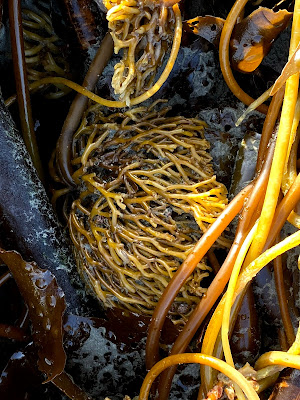 |
| Meares Island 1000 year old tree with our group |
We all know that everything in this world
is interconnected. At least we know it in our heads. But each time I teach one
of my Workshops in Wild Places week-long painting classes, I more clearly
understand the interconnection between the land, our paintings, our lives, our
bodies, our emotions, and our spirit. In teaching about connecting with
the land to create abstract paintings, I realize how the land opens us up, how art opens us up, but only if we
are willing. Leaning against a 1000-year old tree on Meares Island near Tofino,
BC two weeks ago, I was suddenly overcome with emotion. I had such gratitude for
this ancient tree–that I was able to experience it, consider what its seen in
1000 years, stand inside the hollow part of its trunk, and sit on its huge
roots as I leaned on it, feeling its big calm energy.
 |
| Under Mother Tree-photo by Julie Brogan |
In my Workshops in Wild Places, we do
various exercises to connect with the land––walking meditations, sitting
meditations, gratitude meditations, writing, and other reflective activities.
While connecting with the earth, we also connect with ourselves and to deepen
that relationship, I invite artists to ask themselves and the land profound
questions.
 |
| Seaweed on Cox Bay |
While I originally envisioned the workshops
as creating paintings that are reflective of a deep relationship with the land,
I had not given enough importance to the artists’ relationship with themselves
as well as with the rest of their lives. In this last workshop, as one person
struggled with inner conflict, I was reminded that of course, everything is
interconnected. The earth is not separate from our lives, our bodies, our
spirit, and us. We know that in our dealings with climate change. In the same
way, painting is not separate from us or from the world we inhabit.
Everything’s connected.
ME: Why am I alive?
OLD WOMAN: Because everything else is.
ME: No. I mean the purpose.
OLD WOMAN: That is the purpose. To learn
about your relatives.
ME: My family?
OLD WOMAN: Yes. The moon, stars, rocks,
trees, plants, water, insects, birds, mammals. Your whole family. Learn about
that relationship. How you’re moving through time and space together. That’s
why you’re alive.
From Embers: One Ojibway’s Meditations by Richard Wagamese



Thanks for sharing so much of your self with the artistic community. I am always inspired to read what you write. I have ordered the book EMBERS by Richard Wagamese. At this time I am doing detailed drawings of natural objects that I find on my walks and in my garden such as roots, pods, leaves, dried flowers. twigs. I have come to believe that all we have comes from plants and Mother Nature teaches us that all things are connected. What we do to Nature, we do to ourselves. So hugging a tree sounds like a very natural thing to do. You might be interested in a book I am reading: THE REVOLUTIONARY GENIUS OF PLANTS, A New Understanding of Plant Intelligence and Behavior by Stefano Mancuso. It is a fascinating look at plant life and helps you understand an intelligence that is not based in a central nervous system or brain but based in an extreme sensitivity to their surroundings. Which makes me think we humans have lost our sensitivity to our surroundings. But I digress. Again thanks and I hope your Art In Wild Places will continue after the pandemic.
ReplyDelete